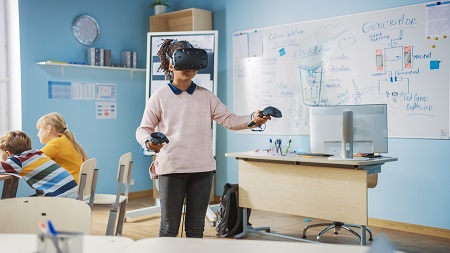
November 4, 2021 | Lynn Schear
EdTech is serious business. Or is it?
Transformative technology continues to dominate the landscape of K–12 school spending, from communication needs highlighted by the pandemic to new learning models that resonate with students in an age influenced by digital entertainment.
Gallup's most recent study on EdTech usage points out just how pervasive digital learning tools have become: "About two–thirds of teachers (65%) say they use digital learning tools to teach every day; 22% use them a few days a week, and 13% use them once or less per week. More than half of teachers (53%) report that their students use digital learning tools every day to learn. About seven in 10 students report using digital learning tools outside of school for schoolwork at least a few days a week," according to the report.
In the past few years, digital and e–learning tools have embraced custom data tracking to elevate their mission beyond mere diversion: Teachers are able to use technology to identify when students are falling behind in specific topics before learning gaps become prevalent. Moving more instruction and classwork to digital platforms also helps prepare the next generation to compete in a global economic landscape. But it's not all a numbers game: The most powerful trends in EdTech are also succeeding because they make learning fun.
The gamification of learning
Remember those gold star stickers? Making learning into interactive, reward–based games isn’t a new idea, but technology has made it a more powerful one. According to a study by BlueWeave Consulting, the global education gamification market reached $697 million in sales in 2020.
Relatability and engagement, especially in STEM, is vital to long–term success, so many teachers have started reaching students in the games they already play. Minecraft, the block–based building game that has experienced explosive popularity since its 2011 debut, has been used to teach kids about architecture, advanced math and DNA, alongside creative performances and projects in worlds kids have created.
Roblox, another popular gaming platform, also lets users program and play games created by other users. Teachers are also creating custom interactive quizzes with resources, such as Socrative, that don’t require upfront coding knowledge. Startups like Thinkific are adding their tools to the field of options for teachers, who are finding inspiration on Pinterest and other social platforms.
Virtual reality and beyond
If you haven't heard the term "immersive learning," get ready. It's a trend that encompasses Extended Reality (XR), an umbrella term for augmented reality (AR), virtual reality (VR), or the combination of related technology with a student's real environment. The idea is to surround a subject with an environment that maximizes the visual learning process, with interactive components that would be prohibitively expensive in the "real" world.
Students and teachers can use immersive learning to explore full–scale dinosaur skeletons, dissect 3–D virtual bodies, or walk among giant models of complex molecules. AR can take the hazard and high cost out of chemistry and other experiments, with companies like the startup Labster offering hundreds of simulations for high school teachers to choose from.
Immersive learning isn't just for STEM. With student travel opportunities still a question mark for most districts thanks to COVID–19, foreign language programs are embracing artificial environments to let students practice their skills and experience a digital copy of other cultures. Students are clicking their way through art museums worldwide and walking through historical battlefields they aren't able to visit in person.
ABI Research, a global tech market advisory firm, estimates the augmented reality market will surpass $140 billion in total market value in 2025. But although the market is booming, the cost of basic AR tools is dropping. In a few years, VR headsets with a price tag of around $200 could be as commonplace in K–12 classrooms as laptops or tablets.
The rise of artificial intelligence
Artificial intelligence has always seemed more like fodder for sci–fi movies than an actual opportunity for educators. But with the increased processing power of both individual computing devices and the cloud, AI is coming into its own for both instructors and students.
Grading and lesson planning takes valuable time away from student interaction. Firms like Copyleaks are enabling digital grading of advanced tests and even essays for teachers, preserving work–life balance and freeing them up for one–on–one instruction.
When artificial intelligence is used to customize instruction, the result is called adaptive learning, another leading trend that will only grow in the years ahead. It’s gaining popularity because, unlike more traditional learning methods, adaptive learning gauges the ability of individual users and adjusts to challenge them. The more an AI platform interacts with a student, the more it learns about how to better teach them. If adaptive learning is fully embraced, it could turn the traditional K–12 classroom upside down, with some students learning in entirely different ways and environments.
What schools are looking for
Some of the leading EdTech offerings sound futuristic and inspiring, but they can also be intimidating. For both startups and firms looking to form new partnerships, simplicity in messaging is key. Teachers, principals and other decision–makers need to see a breakdown of benefits they can understand alongside the "cool factor." Before they make an investment, many educators will opt for a free or lower–cost trial or short–term subscription to a service to try it out – and the training and tech support they receive during this trial period will be vital to their long–term buying behavior.
EdTech is a crowded market. Whatever learning tools you have to offer, it' more important than ever to start with the best data possible. Reach out to an MCH education data expert to talk strategy today.
More Insight From MCH
Need More Time?
Due to inactivity, you will be logged out within 5 minutes.
To stay logged in, please select Stay Logged In.





 Logout
Logout